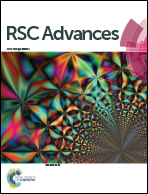The in situ preparation of iron phosphide using ionic liquids as iron and phosphorus sources for efficient hydrogen evolution reactions†
Abstract
Ionic liquids (ILs) were utilized as iron and phosphorus sources for the preparation of iron phosphide for the first time. The IL trihexyl(tetradecyl)phosphonium tetrachloroferrate ([P(C6H13)3C14H29][FeCl4]) and carbon nanotubes (CNTs) were applied as precursors for the in situ preparation of Fe2P(IL6)/CNTs. This material has good catalytic activity and stability for the hydrogen evolution reaction, including a low onset overpotential (75 mV) and Tafel slope (68 mV dec−1). Moreover, this catalyst exhibits current densities of 10 and 20 mA cm−2 at overpotentials of 115 and 150 mV, respectively. The phosphidation process using [P(C6H13)3C14H29][FeCl4] was also investigated. All experimental results indicate that Fe2P can be formed in situ on the CNTs using this IL, and that the CNTs help the formation of the Fe2P nanoparticles and improve the electrical conductivity. This IL-based in situ preparation strategy is facile and environmentally friendly and does not require the addition of other reagents. This method holds great promise for application in other electrochemical studies.



 Please wait while we load your content...
Please wait while we load your content...